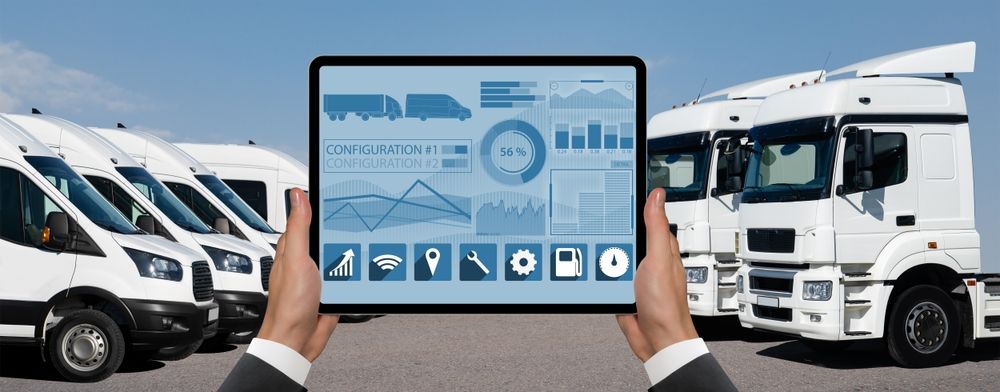How do Toll Payments Impact Your Fleet Costs?

When managing a commercial fleet—whether it’s a handful of service vans or a cross-country fleet of trucks—operational efficiency and cost control are critical. While fuel, maintenance, and labor often get the most attention, toll expenses are a hidden cost that can significantly impact your bottom line if left unmanaged.
Toll roads are a necessary part of modern infrastructure, helping to maintain highways, bridges, and tunnels. However, for fleets that operate across multiple states and regions, toll fees can add up quickly—especially when factoring in toll rate variability, misreads, violations, and administrative overhead.
Understanding how tolls work and their financial impact is essential for making smart business decisions. From route planning to expense tracking and compliance, tolls play a bigger role than many fleet managers realize. By getting a handle on toll-related costs and streamlining toll management, businesses can save money, reduce back-office burden, and optimize fleet performance.
How Tolls Are Collected
Toll collection has evolved significantly in recent years, with many regions adopting more efficient, technology-driven systems. Here are the primary methods used today:
1. Traditional Toll Booths
Once the most common method, traditional toll booths require drivers to stop and pay a toll collector or machine. Payment can be made in cash, by card, or with a transponder. These booths can cause delays, especially during peak hours, and are gradually being phased out in favor of cashless systems.
2. Electronic Toll Collection (ETC) Systems
ETC systems allow vehicles to pass through tolling points without stopping. A transponder—usually placed on the windshield—communicates with roadside equipment to deduct tolls automatically from a prepaid account. This method is faster, reduces congestion, and is commonly used in networks like E-ZPass, SunPass, and FasTrak.
3. Toll-by-Plate
In this system, cameras capture a vehicle’s license plate as it passes through a tolling point. The toll is then billed to the registered vehicle owner, either by mail or through a fleet toll account. Toll-by-plate is often used as a backup for vehicles without transponders, but it can come with higher rates and more administrative work if not properly managed.
Types of Toll Roads
Tolling can be applied to various types of infrastructure, each with its own cost structure and rules:
- Turnpikes and Toll Highways: Long stretches of toll roads, often covering entire state corridors.
- Bridges and Tunnels: Common in urban and coastal areas, especially where infrastructure costs are high.
- Managed Lanes (Express or HOT Lanes): Optional lanes with variable pricing based on traffic levels, allowing drivers to pay for a faster, less congested route.
Each type comes with its own billing systems and pricing models, which can complicate cost tracking for fleets that operate across multiple regions.
Who Sets Toll Rates?
Toll rates are determined by various agencies, including:
- State Departments of Transportation (DOTs)
- Regional Tolling Authorities
- Public-Private Partnerships (P3s)
These agencies consider factors like road maintenance costs, construction financing, and regional transportation budgets. Rates can vary by vehicle class, axle count, time of day, and payment method (e.g., transponder vs. toll-by-plate), which adds complexity for fleets trying to forecast toll expenses.
Why Tolls Matter for Fleets
For commercial fleets, tolls are more than just a routine part of the road—they’re a recurring and often unpredictable operating expense that can significantly impact profitability. Whether your fleet covers local service routes or long-haul interstate corridors, understanding when and where tolls apply is critical to managing operational costs and making smarter routing decisions.
Frequency of Toll Road Usage in Commercial Operations
Fleet vehicles are frequently on the move, covering hundreds or even thousands of miles per week. In many regions, toll roads are unavoidable, especially when drivers need to reach destinations quickly or bypass congested areas. Commercial vehicles often rely on toll roads for:
- Accessing major distribution hubs and ports
- Navigating urban centers with limited non-toll alternatives
- Using express lanes to meet tight delivery windows
- Taking the most fuel-efficient or time-efficient route
Because of this frequency, even small toll charges can accumulate rapidly across dozens or hundreds of vehicles—making toll spend a significant line item in a fleet’s budget.
Regional Toll Variances
Toll costs and systems vary widely across the U.S., which creates complexity for fleets operating across multiple states. Each region has its own tolling authorities, rate structures, and rules, which can lead to inconsistent and difficult-to-predict expenses.
- Northeast: This region has some of the most heavily tolled roads in the country, such as the New Jersey Turnpike, Pennsylvania Turnpike, and New York Thruway. Tolling is dense and often unavoidable for interstate trucking.
- Midwest: States like Illinois and Ohio have major toll corridors (e.g., Illinois Tollway, Ohio Turnpike), but overall toll density is lower than in the Northeast.
- West Coast: California features express lanes and bridge tolls, especially around major metro areas like Los Angeles and San Francisco. Oregon and Washington are also expanding tolling infrastructure.
- Southeast & Southwest: Tolling is growing in states like Texas and Florida, with large-scale toll networks (e.g., Florida's Turnpike, Central Texas Turnpike System) that are heavily used by freight and service fleets.
Examples of High-Cost Toll Regions
Certain corridors are known for especially high toll rates—particularly for commercial vehicles, which are often charged based on weight, axle count, or class. Some examples include:
- New York City Area: Bridges and tunnels into Manhattan (e.g., George Washington Bridge, Lincoln Tunnel) can cost commercial vehicles $80+ per crossing.
- Pennsylvania Turnpike: One of the most expensive toll roads in the country for trucks, with rates exceeding $300 for a full-length trip for 5-axle vehicles.
- Chicago Area: The Illinois Tollway charges variable rates based on time of day and vehicle class. Commercial vehicles can pay 3–5 times more than passenger cars per toll plaza.
- California’s Bay Area Bridges: Toll costs vary by vehicle size and can run $25–$50+ per trip for commercial vehicles.
These costs add up quickly—especially when fleets aren’t proactively tracking and managing their toll activity. That’s why toll awareness and cost control are essential for any operation that spends significant time on the road.
The Hidden Costs of Tolls for Fleets
While toll fees themselves are a known expense, many of the true costs associated with tolling are hidden in administrative inefficiencies, data complexity, and system errors. These indirect costs can quietly erode margins and drain valuable time and resources if not properly managed. Let’s break down some of the most common hidden toll expenses that affect commercial fleets:
Direct Toll Charges Per Vehicle
Toll charges can vary significantly depending on the route, the number of axles on a vehicle, and even the time of day. For fleets with dozens or hundreds of vehicles on the road daily, these direct charges add up quickly—especially in heavily tolled regions like the Northeast or California. When multiple vehicles take routes with repeat toll points or longer distances, toll costs can easily become one of the fleet's top five operational expenses. And without proper monitoring, these charges can slip through unnoticed until it’s too late to optimize routes or adjust spending.
Administrative Time Spent Managing Toll Bills
Without a consolidated toll management solution, back-office teams often spend hours sorting through separate toll invoices from multiple tolling authorities. This includes:
- Reconciling vehicle data with toll charges
- Matching toll charges to specific drivers or trips
- Verifying toll rates and checking for errors
- Manually entering toll data into accounting systems
This kind of manual processing is time-consuming, error-prone, and expensive—especially for fleets managing multiple toll accounts across regions. Plus, managing paper invoices or portal logins across various toll authorities creates unnecessary complexity and friction.
Toll Violations and Late Fees
Violations are one of the most common and costly hidden toll expenses. These can include:
- Missed payments due to misfiled or late invoices
- Vehicles traveling without a transponder
- Transponders not properly mounted or activated
- Unpaid toll-by-plate charges
Many toll authorities impose steep penalties and administrative fees for late payments or violations—sometimes doubling or tripling the original toll. For fleets operating at scale, just a few violations per vehicle per month can result in thousands of dollars in unnecessary costs annually.
Transponder Misreads or Missing Transponders
Transponders are essential for electronic tolling, but they’re not failproof. If a transponder is:
- Not installed correctly
- Assigned to the wrong vehicle
- Damaged or deactivated
- Forgotten during vehicle swaps
Then the system may fail to register the vehicle properly. This often results in toll-by-plate charges at a higher rate—or worse, a violation. These misreads can be hard to identify without a centralized system that flags discrepancies or reconciles vehicle data automatically.
Difficulty Reconciling Toll Data Across Different States or Authorities
Fleet operators dealing with tolls across multiple regions face the challenge of inconsistent data formats, billing cycles, and pricing structures. Each tolling authority may:
- Use different billing platforms
- Display transaction data differently
- Bill tolls weeks after the trip occurred
- Apply varying rates for the same vehicle type
This makes it difficult to get a unified view of toll spending, track trends, or validate charges in real-time. Without a central platform that consolidates and normalizes toll data, fleet managers risk overpaying or missing opportunities to optimize routes and reduce expenses.
These hidden toll costs aren’t always obvious, but over time they can have a major impact on a fleet’s financial health and operational efficiency. That’s why the next section will explore how to get these costs under control with better toll management tools and practices.
How to Manage and Reduce Fleet Toll Costs
With tolls accounting for a growing portion of fleet operating expenses, it's more important than ever to take a strategic approach to toll management. The good news? By leveraging the right tools and practices, fleets can significantly reduce toll-related costs, improve operational efficiency, and eliminate many of the administrative headaches associated with tolling.
Here’s how fleets can take control:
Use of Toll Management Platforms
Toll management platforms like Bestpass are designed specifically to solve the pain points that commercial fleets face when navigating complex toll networks. These solutions act as a central hub for all toll activity—regardless of where your vehicles operate. By integrating with over 50 tolling authorities across the U.S., Bestpass provides:
- One account for nationwide toll coverage
- Automatic payments and violation mitigation
- Seamless integration with fleet management systems
- Dedicated support and insights for commercial operations
For fleets of any size, this kind of centralized management helps eliminate wasted time, avoid missed tolls, and gain full visibility into toll-related costs.
Consolidated Toll Billing
Instead of juggling separate invoices from multiple tolling authorities, a toll management solution provides a single, consolidated monthly statement for your entire fleet. This not only saves hours of administrative work but also simplifies bookkeeping, budgeting, and auditing. With Bestpass, all toll activity—whether it’s E-ZPass in the Northeast, FasTrak in California, or toll-by-plate charges in Florida—is included in one easy-to-read report.
Benefits of consolidated billing include:
- Fewer errors and missed payments
- Streamlined back-office operations
- Easier tax reporting and cost allocation
Real-Time Toll Tracking and Reporting
Having real-time visibility into toll activity is a game-changer for fleet managers. With access to live toll transaction data, you can:
- Monitor toll expenses per vehicle or region
- Identify toll-heavy routes and assess cost impact
- Detect unauthorized toll road use or out-of-route driving
- Pinpoint potential violations before they escalate
Bestpass offers on-demand reporting and customizable dashboards, giving you the tools to make fast, data-driven decisions and take immediate action when issues arise.
Avoiding Violations with Accurate Transponder Placement and License Plate Updates
One of the most common sources of unnecessary toll expenses comes from transponder-related errors—such as misreads, mismatched vehicle data, or missing transponders. With a proper toll management system in place, fleets can:
- Ensure each vehicle is assigned a functioning, correctly mounted transponder
- Automatically update license plates and vehicle details across tolling authorities
- Flag transponders that are inactive or generating violations
- Reduce the risk of toll-by-plate charges at higher rates
Bestpass helps automate transponder and plate management, so your vehicles are always properly equipped and toll-compliant, no matter where they travel.
Leveraging Data Analytics for Smarter Routing
Toll data can be much more than a bill—it’s a powerful tool for optimizing operations. With detailed toll analytics, fleets can:
- Analyze the cost-effectiveness of different routes
- Identify high-cost toll zones and find alternatives
- Balance toll savings against time or fuel efficiency
- Make informed decisions around dispatching and trip planning
Using Bestpass, fleet managers can tap into rich insights that highlight where toll spend is concentrated, how it’s trending over time, and what adjustments can lead to cost savings without sacrificing service or delivery times.
Managing tolls proactively isn’t just about paying less—it’s about working smarter. By embracing tools like Bestpass and streamlining how tolls are tracked, paid, and analyzed, fleets can turn a frustrating cost center into a manageable and even strategic part of their operations.
Take Control of Your Fleet's Toll Expenses with Bestpass
The comprehensive toll management solution designed specifically for commercial fleet operations. With nationwide coverage, advanced analytics, consolidated billing, and real-time insights, Bestpass helps you identify hidden toll costs, avoid costly violations, and streamline back-office processes.
Experience transparent toll management and smarter routing decisions to increase your fleet efficiency—partner with Bestpass today for complete visibility and optimized toll management.

